![Old Chute]() Looking up at the Old Chute, from the Hogsback
Looking up at the Old Chute, from the HogsbackCrux, Located
After 30 minutes of climbing, I was nearing the top of the Old Chute. The slope had increased to forty degrees or so, and I was acutely aware of the long ride down behind me. I was using my axe in the piolet-panne - low dagger - position now, and occasionally scrabbling for a hold with my left hand as well. If I had had a second tool I would have been happy to use it here. About 30 meters below the ridge, the ice bulged out slightly, increasing the angle to near 50 degrees for a stretch of about 5 meters. I paused below this stretch, and hacked out a platform to stand and rest in. My hands were cramping a bit from the death-grip I'd been giving the axe, and the first whisperings of doubt trickled through my brain. Objectively as possible, I assessed the risks and decided that I had the right skills and gear to pull it off. I continued up, occasionally kicking my crampons in four or five times, and looking for features in the surface where I felt they would get better purchase. Near the top of the bulge, as I brought my eyes up to place the axe again, I found myself staring into a horizontal fissure. It was only about 30 centimeters wide, but it was deep, and the bottom disappeared into the ice. The sides of the crack went from white near the surface, to a deep glacier blue, to black. As I stood there in my exposed position, a cold breath of air brushed my face from the depths, an exhalation from the living ice. The hair on my neck stood up, and I began to notice small sounds coming out of this crack, as if small animals were at work in the depths. I came to realize that this fissure was the bergschrund for the slope. I traversed right with a real sense of urgency until I was around this crack. There were a couple of additional moves upward which took place in that hyperclarified space at the edge of panic, and I noticed that I had been talking to myself during those moves. Then, I was above the crack, and the slope lessened again.
Summit
As I topped out on the ridge, then sun began to rise, and the brilliant light refracted through the translucent edge of the cornice ice like a ribbon of fire. I was ecstatic. From the top of the Old Chute to the summit proper is a knife-edge walk of about 150 meters. The National Park Service climbing conditions report for the previous week describes it thusly, "to one side of the ridge there is a 2000 foot drop, to the other side is a 150 foot drop." Buffeted by the wind, I followed the remnant of the packed-down boot trail. Portions of the summit traverse were actually on bare rock, which is markedly different from earlier in the season, so I've been told.
![Summit Ridge]() Looking towards the summit from the top of the Old Chute
Looking towards the summit from the top of the Old Chute
At the summit, I exulted in the sun and wind. There were at least six volcanoes visible from the summit. I signed the summit register, which was a handsome leather-bound journal. Keep it classy, Oregon.
![Summit Register]() Mount Hood's summit register, with Mount Jefferson in the distance
Mount Hood's summit register, with Mount Jefferson in the distanceSurrounded by volcanoes.
![Summit Panorama]() From left to right, the truncated dome of Mt. St. Helens, Mt. Rainier, Mt. Adams
From left to right, the truncated dome of Mt. St. Helens, Mt. Rainier, Mt. Adams![Summit]() Looking from the summit back towards the top of the Old Chute
Looking from the summit back towards the top of the Old Chute
Rock!
On the descent of the chute, I met a party of three ascending. We were all spread out across the chute. As I conversed with one man, another member of their party shouted, "Rock!" He had spotted a softball-sized chunk break off the face on the west side of the chute, no doubt liberated by the sun's rays which were just beginning to hit the rock there. All four of us watched tensely as the rock accelerated and caromed down the chute. It took unpredictable bounces on the rough ice, and I shifted my weight back and forth, trying to read the line it was taking. As it got closer I tensed in preparation for a last second dive, axe at the ready. It whizzed by to my left, 3 meters away. Seconds later a small cascade of ice and snow that had been knocked loose hissed by. I have read that a rock of that size can break your arm at that speed. I was glad to have my helmet. Readrenalized, I hustled down.
![Succcess]() Back at Crater Rock (Old Chute visible in upper left corner)
Back at Crater Rock (Old Chute visible in upper left corner) Summary
This mountain is loads of fun. Just be prepared for a bit of exposure, and if you go late in the season, watch for crevasses, weakened snow bridges and rockfall. Get up and down when everything is still frozen. This mountain receives heavy visitation, but if you go on a weekday outside of peak season, you might get lucky like me and have the place to yourself.


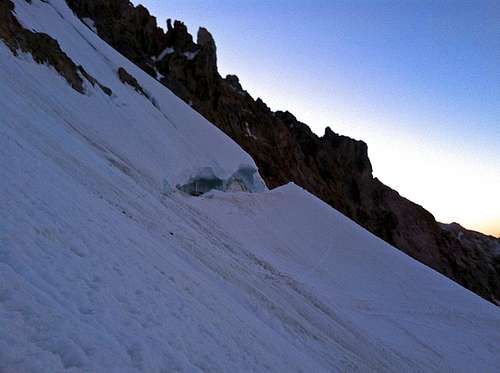
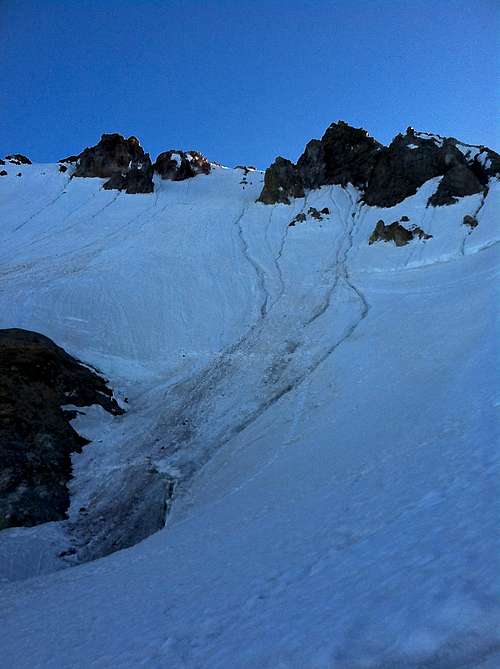
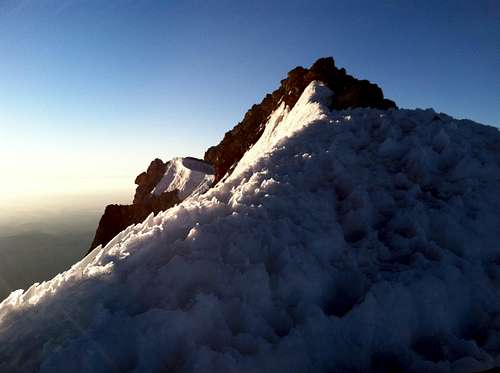
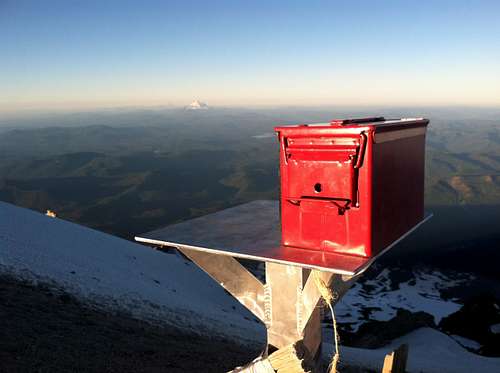

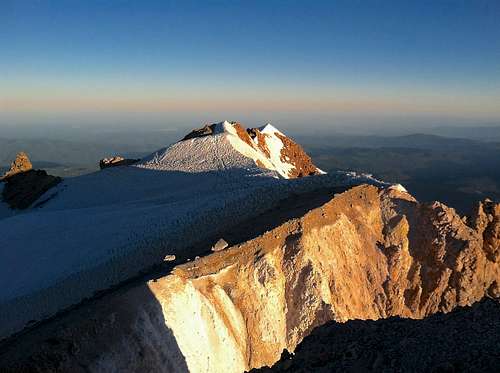
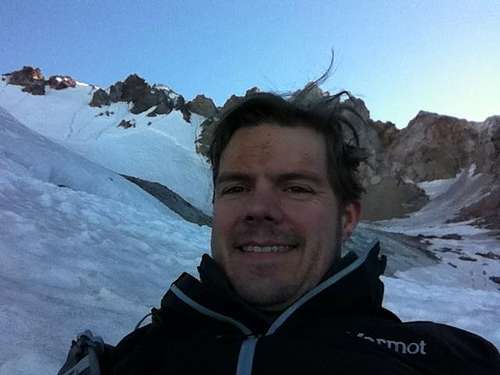


Comments
Post a Comment